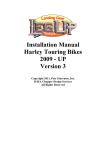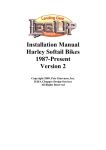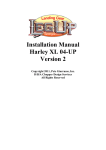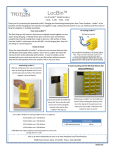Download 88-2000 GL1500 - GEN I (Obsolete)
Transcript
Installation Manual GL-1500 Version 2.2 Copyright 2011, Pete Giarrusso, Inc. D/B/A Chopper Design Services All Rights Reserved 2 Table of Contents INTRODUCTION .................................................................................... 4 WARRANTY ............................................................................................ 5 INSTALLATION INSTRUCTIONS ...................................................... 6 COMPONENTS: .................................................................................................... 6 1) 2) 3) 4) 5) 6) 7) 8) Control Switch Box...................................................................................................... 6 Linear Actuator ........................................................................................................... 6 On-board Computer Module ....................................................................................... 6 Proximity Sensor ......................................................................................................... 6 Leg Support Stand ....................................................................................................... 6 Leg/Wheel System ........................................................................................................ 6 Hardware Bag.............................................................................................................. 6 Actuator Bracket.......................................................................................................... 6 PREPARE FOR INSTALLATION ...................................................................... 7 INSTALL LEG SUPPORT STAND ..................................................................... 8 ACTUATOR BRACKET ....................................................................................... 10 LEG/WHEEL ASSEMBLY ................................................................................ 12 CONTROL SWITCH BOX ................................................................................. 15 INITIAL SYSTEM TEST .................................................................................... 21 FINISHING UP ..................................................................................................... 23 TRIM THE MUFFLER COVERS................................................................................... 23 ACTUATOR ADJUSTMENT (Maintenance Mode) ....................................................... 24 TEST RIDE ........................................................................................................... 25 LEGUP LITE - ADDENDUM ............................................................................. 27 ILLUSTRATIONS ............................................................................................... 28 Wiring 1 ............................................................................................................................ 28 Wiring 2 ............................................................................................................................ 28 Wiring 3 ............................................................................................................................ 29 HARDWARE LIST .............................................................................................. 30 WIRE TIES, TIE DOWNS, ETC. ................................................................................ 30 3 Introduction This manual covers installation of the LegUp Landingear system by Chopper Design Services. This system should only be installed by a qualified technician, or those with above average mechanical skills. If you are not SURE that you can perform this installation, please contact us and we will help you find a qualified shop to assist you. If you have been looking for a system that will keep your feet on the pegs, this is NOT the system for you! On the other hand, if a system that will relieve you of the weight of the bike and help you avoid balance problems as you approach a stop, LegUp is what you need. Improper installation will void your warranty, so please be very careful! Thanks for choosing LegUp! 4 Warranty Chopper Design Services warrants the LegUp system for a period of one year from date of purchase. This warranty covers replacement parts and/or manufacturer defects. Incidental damages or costs are the responsibility of the purchaser. Defective parts are to be returned to Chopper Design at the address below. Purchaser must contact Chopper Design to receive a Return Material Authorization, prior to returning defective parts to Chopper Design. Abuse, improper installation or use, collisions or accidents, are not covered under this warranty. Replacement parts for this type of damage are available through Chopper Design. Users of the LegUp system agree that Chopper Design is NOT responsible for personal injuries or damage to property arising from the use of the system. While we believe this system to be safe and reliable, the user is advised that use of LegUp is done so at the users’ own risk. Use of the system implies agreement to the above statements. If you can’t agree with the above, Chopper Design and its dealers would be happy to refund your full purchase price, before you use the LegUp System. Chopper Design Services 1365 Bennett Dr #101 Longwood, FL 32750 407-834-5007 [email protected] 5 Installation Instructions The LegUp® system has many components. Pleased be sure you have them all before starting your installation. COMPONENTS: 1) Control Switch Box 2) Linear Actuator 3) On-board Computer Module 4) Proximity Sensor 5) Leg Support Stand 6) Leg/Wheel System 7) Hardware Bag 8) Actuator Bracket If you believe you are missing any parts, please contact Chopper Design at 407-834-5007, and we will rectify the situation. Figure 1 6 PREPARE FOR INSTALLATION Place the motorcycle on an acceptable bike lift. You will need to keep the bike on its wheels for most of the installation, and jack the rear wheel off the lift for some portion of the installation. Make SURE the motorcycle is secure on the lift! Remove the seat, left side cover (fuse box) & rear muffler covers. They are not needed until the very end of the installation. The GL1500 has many covers and pieces that need to be removed and/or reinstalled during this installation (like the center stand). While we have worked diligently to make this manual very thorough for the installation of your new LegUp system, we DO NOT cover all of the details on how to remove and reinstall some of these parts. Please consult a service manual or a qualified technician to help with these items, if required! We are now ready to begin! NOTE: If your bike has fixed rear floorboards, you will NEED to either remove them, leave them in the upright position at all times, or get a ‘Floorboard Riser’ kit (Show Chrome Part # 52-693) to raise the left floorboard a bit higher to clear the actuator once installed. Adjustable floorboards can be adjusted high enough, and rear foot pegs have plenty of clearance! We can furnish you with the riser kit if you need it. At the time of this printing, list price was $97. 7 INSTALL LEG SUPPORT STAND LegUp has developed a new, stronger attachment system which attaches to the GL1500® via the holes from the stock center stand, and the bolts that support the exhaust system at the rear. You will need to remove the stock center stand and its’ shaft. The center stand will not be re-used, so keep the parts together and set them aside. Remove the 2 bolts that secure the Catalytic Converter on each side of the bike, and set them aside (we have replacements for them). You will find that these supports have rubber around the edge of the metal support. Using a sharp knife or razor blade, carefully trim back the rubber so its diameter is the same as the support. The small rings in the picture below need to slide over these supports. Keep trimming until these fit (they slip on); you can even tap lightly to get them on the support. Once this is accomplished, the two rear supports (blue above, attached to the rings) can be attached using the chrome bolts supplied. Note the differences between these two brackets (right one has two sloping sides, left one only one) and their orientation (right one has flat in towards bike, left one out away from bike). Thread the bolts through the holes in the brackets (aligned as in the picture below), bring the brackets up to the rings (there is a machined recess they line up to the rings with), and push the bolt through the exhaust mounts and start the nylock nut on the back. Tighten the bolts reasonably tight. We need these brackets to be able to rotate around the bolts to line up to the plate later. If you get them snug but still moveable, you won’t have to tighten them later (which can be tricky). 8 Next find the small chrome bolt and insert it into the pinch bolt bracket on the right side of the bike (below, right) where the center stand was removed. Start to thread the bolt but don’t tighten it yet! The next step is to find the stainless shaft (9.25” long) and begin to slide it through the big holes now empty from the Center Stand from the left side of the bike. Once you start the shaft into the hole, raise the plate (Red above) with the two front brackets (Gold Above) attached loosely up toward the bike (a Helper is handy here), and slide the shaft through the two forward brackets, and through the other hole in the frame left by the center stand. Make Sure the shaft is all the way through the second bracket. Once you are certain you have these brackets oriented properly, tighten the pinch bolt you just installed so the shaft will not move. The Big plate will now pivot just a bit on the shaft you just installed and fall below the first brackets (Rear Brackets) you previously installed. Now comes the fun part. Find (4) 3/8” gold looking bolts with lock washers and barely start threading each one into the elongated holes on the bottom of the plate to meet the threads in the rear brackets. This can be tricky. Sometimes loosening the front bolts a bit will give you more leeway to find the threaded holes. Once all the bolts are started, start tightening all of them down a little bit at a time, until all are VERY snug and nothing seems to be in a bind. The mount should be firmly attached to the bike now; go ahead, give it a tug! You can now remove one of the chrome bolts on the end of the shaft at the very back of the plate, push the shaft out and set it aside for now. Once the support stand is installed, we can move onto the installation of the actuator bracket. 9 ACTUATOR BRACKET The actuator bracket mounts to the vehicle on the left rear saddlebag guard. It is a sort of ‘Sandwich’ arrangement, to spread the load across the front and rear legs of the guard. IT IS CRITICAL THAT THIS GUARD IS IN PERFECT CONDITION AND HAS NEVER BEEN BENT! THE ENTIRE ACTUATOR GEOMETRY RELIES ON THIS! REPLACEMENT LEFT CRASH BAR/SADDLEBAG GUARDS ARE AVAILABLE THROUGH YOUR HONDA DEALER. The first step is to take a tape measure, hook the end under the lip of the front rail of the guard, and mark the rail with a sharpie at a point that is 3 3/4” out from that in-board end of the guard. Here is a picture of the two part bracket. The piece that is threaded with the ‘U’ shaped extension is the top! We didn’t get any pictures while the bike was in the shop, so we took them on our mockup Saddlebag Guard! We recommend that you loosen the left saddlebag for the next steps. Open the saddlebag and remove the forward bottom and forward top bolts. Loosen the rear top and bottom bolts. This should allow you to raise the front edge of the saddlebag slightly to allow us to install the actuator bracket. Take the top half of the bracket in hand, and with the back (the part furthest from the upper overhanging piece with the holes in it as shown above) closer to the bike, gently slide the front edge over the top of the front bar. Next take the back and move it to get the half-round pipe over the top of the rear of the bar. You may have to lift the front edge of the saddlebag to accomplish this! Once the top half of the bracket is in place, slide it along the bar toward the bike and line up the inside edge with the mark you made on the bar. 10 Next take the bottom part of the bracket with two bolts and lock washers, hold it on the bottom of the rails, line up the holes (they are oversized on the bottom to make this easier) and start the bolts into the top bracket. The square end goes toward the front of the bike; the long end of the slanted side goes closest to the bike. Rounded edges face away from the guard. The plate just lies under the saddlebag guard as shown here. Just snug these bolts a small amount for now. As you tighten them, you need to move from the front bolt to the back to keep the gap reasonably uniform between the brackets! We don’t want to tighten these completely until we see if the actuator lines up with the legs. Don’t worry if the half-round pieces don’t seem to fit perfectly at this point. They will pull themselves around the bar as we tighten the bracket later. When you are done, the actuator bracket should look something like the picture to the above. We will tighten the two bolts on the bottom later when we verify that the actuator aligns properly. Now let’s mount the Leg/Wheel Assembly! 11 LEG/WHEEL ASSEMBLY With help from an assistant, slide the Leg/Wheel Assembly around the rear tire (careful of the finish!), and align the Leg Mounting Points (they have the bronze bushings in them) with the slots in the Support Stand. If available a very small amount of ‘Never Seize’ on the shaft is in order here. Then start the stainless steel shaft in from one side through the tube on the support stand, and through the first leg mounting point and its bushing. The fit is tight, so take your time. Carefully work the shaft through the tube and the second leg mounting point. The shaft is inserted properly when it is inserted just past (approximately 1/8”) the end of the tube. This distance should be about the same on both sides, but it is not critical as long as both sides are inside the tube. If you need to, you can tap lightly on the shaft (brass drift is preferred here). Once the shaft is in place, use a small amount of blue thread locker and install the (2) chrome bolts and washers on the end of the shaft to finish it off. Make sure the legs move up and down without any binding! 12 MOUNT ACTUATOR We can now mount the actuator to the Upper Actuator Bracket we installed a few minutes ago. The round shaft faces up with the shorter cylinder facing forward as you can see at right. A long Chrome Button-head screw is slid through the hole in the bracket, then the hole in the actuator, on through the rest of the bracket, and then capped with the Nylock nut. You can let the actuator dangle, and don’t worry about the wire or the plug at this point. Tighten the Nylock! Next remove the axle from the lower actuator bracket (the silver piece on the left side of the left leg). Gently raise the legs and align the bottom hole of the actuator with the hole in the lower actuator mount, and reinstall the axle. No Loctite yet, as we may have adjustments! (Don’t forget to remove and Loctite this later!) NOTE: If the actuator is too short to reach the other mount you may have to lengthen it using the system. Temporarily plug the wiring harness into the bike, attach the 2 hoop connectors to the fuse box (as described on page 18), and follow the directions for ‘Maintenance Mode’ in the ‘Initial System Test’ section below. Using what would be the left button on the switch box, just add a small amount of length to the actuator so you can align the mounts, then turn the bike back off. 13 At this point you need to make sure that the mounts are in alignment and the actuator is not in any sort of bind! Check from behind the bike to make sure the actuator looks like it is in a straight line. It should have slipped into its’ lower bracket easily, without having to bend the actuator one way or the other. If it did, Great! If not, you may have to adjust the top or bottom actuator bracket to get everything into alignment. Whatever you have to do to make sure the actuator is in a straight line now is the time to do it! Assuming you are successful here, we can lock down the upper actuator bracket. Tighten each bolt a bit at a time trying to keep the gaps between the two pieces reasonably even. Typically the gap at the back will be a bit smaller than that toward the front. (SEE BELOW!) Just keep alternating front and back until the bracket is tight to the crash bar. You may wish to check this bracket from time to time to make sure these bolts remain tight. On to the Control Switch Box! 14 CONTROL SWITCH BOX NOTE: If you have a LITE System, Please refer to the addendum at the end of this manual, for differences between a Regular and LITE Harness! Lite Systems do NOT have Proximity Sensors. Ignore all references to the Proximity Sensor, it’s Mount and wiring. The switch box should already be mounted to a black mounting plate. The switch box mounts under the left grip and attaches to the left switch housing by a single bolt. Remove the bolt from underneath the left switch housing using a Phillips screwdriver. Using the bolt provided, slip the bolt through the black plate and spacer, and then thread it into the switch housing. This bolt needs to be snug as when the buttons are pressed, we don’t want the housing to pivot on the bolt (picture below). Square the box before tightening the bolt. Route the wire down the handlebar and leave it loose near the front forks to be routed under the seat with the proximity sensor wires. Use wire ties to hold the wire to the bar. At this point we need to find the proximity sensor (yellow thing) & bracket and get the plug off the end. The wires from this sensor need to be routed from the front left fork area, up toward the handlebar, to join the wires from the switch box. Route the wires under the caliper cover if one exists, and up the fork leg. Here is the fun part! We need to get the wires from the front to the area under the seat. You can remove the wires from the plug on the end of the switch box wire, join them with the 3 wires from the proximity sensor (plug removed here as well!), and tape the silver plugs together. As shown to the left, take the two bolts out of the bottom of the dash near where the front of the seat would be. Next open the fuel door and find two nylon levers; one left and one right, and rotate them toward the gas cap. This will 15 release then entire dash cover to allow us to route the wires below it. Once the dash is loose, you can lift up on it to allow you to route the wires beneath it without binding them. There is a small rubber piece in front of the dash that you can snap loose if this helps, but do what you need to do to get this wire bundle under the seat. Once the wires emerge in the area under the seat, pull on the wires, making sure they move easily. If not, there is a bind. See if you can clear this bind, or pull the wires back out and start over (Sorry!). Once this works out, carefully remove the tape to expose the silver pins. Check the pins to make sure none where damaged during the process. Make sure the wires under the fork have enough room to allow the bars to be turned and that they don’t get caught on anything. The next step is to reassemble the plugs. Use the diagram at the start of this section for the switch box, and the picture below for the proximity sensor. Be very careful to make sure the wire colors all match those in the mating plug and the diagram. Now onto the rest of the wiring harness! 16 WIRING HARNESS NOTE: If you have a LITE System, Please refer to the addendum at the end of this manual, for differences between a Regular and LITE Harness! The next step is to route the wiring harness. The harness and the plugs are routed mostly under the seat and left side cover. The most difficult task is taking apart the 12 pin plug on the harness and feeding it into the trunk or side box, whichever you like. Decide which location you wish to place the computer, and drill a small (3/8” or so) hole to allow the wire to get into the box you chose. Run the wire through the freshly drilled hole, keeping in mind that you have to leave room under the seat for some slack once the seat is reinstalled. Carefully reassemble the plug (diagram at end of manual). It can’t be stressed enough that these wires have to be perfect! Using the provided Velcro, attach the computer box to the bottom of the compartment in the trunk, or the back of the left side box, with the plug facing in whatever way makes it easy to attach the plug you just reassembled. Plug the computer into this plug and carefully pull any excess wire out of the box, leaving enough wire in the box to easily plug and unplug the computer. You need not worry about heat from the computer or anything like that. Now that the computer is attached, we can pay attention to the wires under the seat, and the side covers. The proximity sensor is next! 17 Find the proximity sensor (little yellow square on a bracket with a long thin wire with a three pin plug attached. The sensor and its’ bracket should already be dangling near the left front fork. NOTE: We will mount this bracket in this area later, but making sure you have enough wire to mount it and that the extra slack is pulled to the under seat area! Make sure the wire is clear of everything, bearing in mind that you need to leave some slack to allow the suspension to move up and down. Once you are satisfied, plug in the proximity sensor with its’ mating plug. Next we need to route 2 wires to the left side cover area. The six pin plug, and the wire with 2 hoop connectors on it, needs to find their way into the side cover area. In the picture at left, you can see where we want to route these wires to get to the fuse-box area. Once routed, we want to remove the fuse-box cover and find the two Phillips head screws that we are going to attach to for power. Using a Phillips head screwdriver, remove the left screw, and attach the orange wire to this post. The black wire gets attached to the right post. You will need to cut two small notches in the top of the fuse box cover to route the wires out of the fuse box, once the cover is reinstalled. The wires can then be routed out of the fuse box to the left & right where you cut the relief for each. These connections are only HOT when the bike is either on or in accessory mode. 18 The other plug we just worked into this area supports the linear actuator. Look at the picture to the right and notice how we route the wire from the actuator up into the side cover area (it fills the groove in the cover left over from the center stand!). We tie this wire off to the support for the muffler cover, leaving a loop for actuator travel. We then run the wire behind the left floorboard into the side cover area. Once this wire is in the side cover area, attach it to its’ mating plug and secure it in such a way that the side cover can be reinstalled with out a problem. Test fit the side cover; on and off to make sure. Verify that it fits and leave the side cover off for now. 19 The only plug left to deal with is the one from the handlebar switches we routed earlier. Reassemble this plug, if you haven’t already, and plug this into the matching plug. Now would be a great time to carefully move the wires under the seat area around and tie them off so they don’t interfere with anything. Any extra wire should be wound up and tied off neatly. Please make sure that the wires will not be under any strain and that the seat and the side covers can be reinstalled without any problems. Once complete, it should look something like the picture below! Now that the entire system is wired, we move onto the Initial System Test. 20 INITIAL SYSTEM TEST NOTE: If you have a LITE System, Please refer to the addendum at the end of this manual, for differences between a Regular and LITE system. Skip this section if you have a LITE System. Turn your bike to Accessory Mode. This is the first click on the key on the GL1500. The screen on the dash should light up. At this point, have a look at the yellow proximity sensor. The RED LED (ON The Sensor) Should Not Be Lit. Take a metal object (screwdriver, wrench, etc.) and hold it on the flat face of the sensor (it has a circle embossed in it). The LED should light up, and go out when you move the metal away. If not, check all your connections. Next, press the rightmost pushbutton and hold it for at least 3 seconds. One or both LEDs on the switch panel should light up; we really don’t care which at this point. If this occurs, you are doing well. If both LEDs are flashing (maintenance mode) you can skip the next step which is to press and hold both buttons until both LEDs flash. Next press both buttons for just an instant! If everything is working, the bottom or yellow LED on the switch box should flash, and the top LED should be out. The next step, and be careful here, is to touch the left button for a split second. The legs should move down just a bit. Touch the right button, and they should move up. With the bike on the lift, you have to be very careful here! If all of the above has occurred, raise the legs. Press and hold the right button until the legs come up all the way, and turn the ignition switch off! The test is now complete. Let’s move on to mounting the Proximity Sensor. 21 MOUNT PROXIMITY SENSOR NOTE: If you have a LITE System, Please refer to the addendum at the end of this manual, for differences between a Regular and LITE system. Skip this section if you have a LITE System. This step is crucial!! Understand it before starting. The proximity sensor tells the system how fast the bike is traveling. The proximity sensor mounts to the bottom left pinch bolt of the left front fork. Remove this bolt, install it through the bracket and reinstall the bolt semi-tight, so the bracket can be moved if need be (a little Locktite please!). You need to jack up the front wheel or have the bike on the ground so we can spin the front wheel to test the sensor and its placement. Make sure the bike is in neutral. The sensor will track the rotor bolts on the front wheel as it spins, and is to be mounted 5MM away from the bolts or closer. Look at the picture at the right. Once the bracket is mounted, turn the key to the accessory position, spin the wheel or roll the bike and watch the behavior of the sensor as the bolts pass it. The LED on the sensor should be off when no bolt is passing the sensor, and the LED should light when a bolt passes by the sensor. Play with this by rotating the wheel back and forth while adjusting the bracket in, out, left or right until the light blinks consistently. Once you feel you have the right place, tighten the bracket down and slowly rotate the wheel. Every time a bolt passes, the light should get bright when the bolt is nearby and off after it passes. If this is not happening, you may need to get the sensor a bit closer to the bolts (5MM is a very small distance!). If you have to move the sensor closer, just loosen the bolt again, and re-adjust the sensor. Bend the metal bracket if you need to; it is stiff enough to stay where you bend it to! No matter what you need to do, you MUST make sure that as the wheel turns, the light works as described above! Once you are certain, tighten the bracket down very firmly! Re-check that everything functions properly by spinning the wheel past all 6 rotor bolts and verifying that the LEDS changes as described above. The automatic retraction of the legs as well as their deployment RELIES on this sensor being placed perfectly! Once satisfied with the mount, make sure the wire running up the fork leg is tied off, clears everything, and can’t get damaged by anything. 22 FINISHING UP TRIM THE MUFFLER COVERS Now it is time to reinstall all the covers and extra pieces that were removed to allow the installation. We will need to clearance the muffler covers to allow the wheels to come up all the way. Hold the covers in place then raise the legs and check where the legs contact the covers. In the picture below, we have tape on the areas you will need to cut in order to allow the wheels to come up as high as they can. Normally the wheel system will contact the very front of the left muffler when it is full raised, given you the MOST lean angle you can have with the legs up. Use tin snips or some sort of metal saw to cut this metal away. Once complete, the muffler covers will still cover the transition from catalyst to muffler it always did, and the cuts will be next to impossible to see. Put the covers on, test the legs, trim some more until the covers don’t touch the legs at all when fully raised Now we can put on any covers we may have left off, make sure the seat goes back on and make sure that everything is clear. This would be a great time to double check all the bolts and see to it that none of the wires are in any kind of distress! Once you are comfortable that everything is correct, get the bike off the lift so you can dial in the actuator, and adjust the wheels. 23 ACTUATOR ADJUSTMENT (Maintenance Mode) NOTE: If you have a LITE System, Please refer to the addendum at the end of this manual, for differences between a Regular and LITE system. Skip this section if you have a LITE System. Before we teach the computer how high ‘UP’ is and how low ‘DOWN’ is, we need to set the air shocks to their highest position. Realize that the LegUp system will be the sturdiest at the lowest shock position, but will work at any settings. We just want to set things with the bike as high as it will ever get. Once you have the bike on the ground, turn the ignition to the accessory position and start the LegUp System (hold right button for 3 seconds). The system should enter maintenance mode automatically (Both LEDs Flash), but if it does not, enter maintenance mode manually (Both buttons for 3 seconds). With a helper nearby, straddle the bike, and hold it level. Hit both buttons for an instant to get the system in the “DOWN” setting mode (yellow LED flashing). Straddle the bike so your weight is NOT on the seat, hit and hold the left button until the wheels contact the ground and stop. Make sure that the suspension raises a bit as you do this. If not, the legs are not going down far enough, the bottom actuator mount may need to be moved left or right a bit to get the wheels all the way down (Contact LegUp for assistance if you need help with this). Once these wheels are down as described above, try to put both feet on the floorboards. The bike should be reasonably stable and you should be able to lean a bit in both directions without the bike falling over. The DOWN stop is now set! Hit both buttons for a moment to get into the “UP” stop mode (top LED blinking). Carefully use the right button to raise the legs. Have your helper let you know as you approach anything that may come in contact with the wheels or the legs. You also need to make sure the system clears pipes, clamps etc. If you can’t make the clearance to allow the legs to come up all the way, you can set the up stop just below whatever is interfering (if not, you will likely set up a permanent rattle!) Hit both buttons when complete, and you will be done with these adjustment. Now press the left button and the legs should lower. Hit it again and the legs should retract. If you are satisfied with these limits, you have successfully installed the LegUp System. Time for a test ride! 24 TEST RIDE NOTE: If you have a LITE System, Please refer to the addendum at the end of this manual, for differences between a Regular and LITE system. Deployment and Retraction of the wheels is COMPLETELY MANUAL if you have a LITE System. Get the bike to a clear paved mostly level area where you can test ride it. Start the bike, turn on the LegUp system and lower the legs. The first test should be done in a straight line. Put the bike in gear and slowly accelerate. You may notice that the bike tends to want to steer a small amount left or right. This is normal unless it is severe. Once underway, the top LED should flash at around 6 MPH, meaning the legs are retracting. You can lean on one wheel or the other as you leave to reduce any darting the system may be giving you. Assuming the legs are retracted, you should try to deploy the wheels. As you come to a stop, the Green LED should be on. As you slow down (almost stopped), the Yellow LED should illuminate at the proper speed. Once it does (sometimes hard to see), hit the left button and put your feet down near the ground. The top LED should flash and you should soon feel the wheels deploying underneath you! Make sure you are ready to balance the bike! Uneven ground or lack of familiarity could make the bike want to lean one way or the other. With your feet ready to balance the bike, this should be no big deal. The slower you are going when deploying the wheels, the smoother the transition will be from wheels up to wheels down. Practice these maneuvers until you are comfortable with the wheel adjustments and the system operation. SEMI-AUTOMATIC DEPLOYMENT: Another way to deploy the legs is to hit the left button while you are running at any speed over 10MPH with the wheels up. The bottom or yellow LED should start to flash. When you slow down to around 8MPH the wheels will start to deploy (see the red/green flash on top LED). Again prepare to put your feet down. NOTE: The bottom LED Should not be LIT if the legs are up over 10MPH! In the event it is, the wheels will deploy instantly if you try to set them as above; this is dangerous! You MUST re-visit the sections on testing the proximity sensor. You should always be aware that this light should NOT be on if you are traveling at speed, and ‘Arming’ the system for deployment should only be attempted if the lower LED is Not Lit! Please see the User Manual for more information on Proximity Sensor Failure! 25 The next thing to try is to make a turn right after a dead stop with the wheels down. As soon as you start the bike moving, try a left or right turn immediately by leaning into that turn. You may find that you have to nudge the bike a little bit more than usual to get the bike to lean, and you won’t be able to lean as far as you can with the wheels up. Once into the turn, accelerating will raise the wheels. You will hardly notice the wheels coming up unless you see the top LED blinking! The next thing to try is slow speed maneuvering with the wheels lowered. In a straight line on level ground, you should be able to keep your feet on the floorboards and move the bike forward at very slow speeds (simulate stop and go traffic). I like keeping my feet near the ground during these maneuvers! You can also try small ‘Trike’ turns; keeping the bike upright at slow speed and making turns as you would in a parking lot. Be aware that if you get over the speed that the legs come up, they will!!! Another thing I like to do is donuts. Start out slow, lean the bike left or right, and make circles at very slow speeds (throttle on, rear brake on, clutch slipping… you know like the cops do!). This helps you get familiar with the wheels being on the springs and allowing a lean angle! Practice, practice, practice!! Enjoy your LegUp System! 26 LEGUP LITE - ADDENDUM If you have a Lite System, there are a few differences in the wiring compared to our Regular system. The plugs and their locations don’t change at all! Instead of plugging in the computer to the twelve pin plug, the Relay-Pack gets plugged into this plug. The Relay-Pack will be attached with Velcro as the computer would have been in the same location. On the LITE system there is no proximity sensor, so ignore the testing and mounting of this sensor, and realize that the three pin plug will be left without a mating connector. We keep this plug in the wiring harness in case you upgrade to a regular system in the future. Using Your Lite System: Unlike our Regular System, you don’t turn the LITE system on, or adjust the legs as described in the ‘Maintenance Mode’ section of the manual. When you turn your bike on, the LITE system is ready to go! Press and hold the left button to lower the wheels, press and hold the right button to raise them. No lights will flash; it is up to you to control the system manually! Please use EXTREME Caution when using the LITE System! Keeping the wheels lowered at speeds over 9MPH can be dangerous. Since the system is manual, please don’t allow its’ operation to distract you from controlling the vehicle! Upgrading Your LITE System: If you have a LITE System and have chosen to upgrade it to the regular system, there are just a few things you need to do. Unplug the Relay-Pack, and plug the computer in where the RelayPack was attached. Run the wire for the proximity bracket and plug it in, test it, and mount it, as described in the ‘MOUNT PROXIMITY SWITCH’ section of this manual. Once the new pieces are attached and plugged in, refer to ‘ACTUATOR ADJUSTMENT (Maintenance Mode)’, earlier in this manual to set the lower and upper stops for the computer. That’s all it takes! 27 ILLUSTRATIONS Wiring 1 There are three different types of actuators with three different wiring configurations. Refer to the notes at the bottom of the pictures above so you can match your actuator with its wiring scheme! Wiring 2 28 Wiring 3 29 HARDWARE LIST (1) 1/4 - 20 X 2” Hex Head Pinch Bolt w/ Nylock Nut & 2 Flat Washers - Chrome (2) 5/16 – 18 X 2.25” Chrome Allen Bolts (Rear Uprights) (2) 5/16” Chrome Washers (2) 5/16” – 18 Nylock Nuts – Chrome 1/4 - 20 X 2.5” Chrome Button Head Bolt (Upper Actuator Bracket) 1/4 - 20 Nylock Nut – Chrome (2) – 5/16” – 18 X 1.50” Cad Hex Bolts (Upper Actuator Mount Plates) 10-32 Allen Head Bolt cut to 1.3” (Handlebar Box) #M5 – Black Allen Bolt cut to 2.97” (Handlebar Mounting Bracket) (2) 3/8 – 16 X 1.25” Cad Hex Bolts (Right Rear Upright) (2) 3/8 – 16 X 1.00” Cad Hex Bolts (Left Rear Upright) (4) 3/8” Cad Split Washers (4) 5/16 – 18 X .75” Cad Hex Bolts (Front Upright) (4) 3/8” Cad Split Washers Wire ties, tie downs, etc. 30









































